by Martin Green
Glashütte, located in the beautiful state of Saxony in Germany, is the epicenter of German watchmaking.
Glashütte’s horological foundation was laid in 1845, largely thanks to four very talented watchmakers, beginning with Ferdinand Adolph Lange and followed by Moritz Grossmann, Adolf Schneider, and Julius Assmann, whose work put Glashütte on the map as a serious force in high quality precision watchmaking.
Grossmann’s founding of the local watchmaking school in 1878 completed the necessary steps toward preserving their legacy for the next generation to build on.
Watches from Glashütte became renowned for their high quality, and the name of the town became a seal of approval to many people in the market for a new watch.
As is so often the case with things that do well, watches from Glashütte began to be copied. To battle this, the firms began adding the word “Original” to their products.
Glashütte and its watchmakers flourished until World War I and the ensuing depression, which had a large impact on the demand for the town’s quality products, yet this could still not compare to the times that were to follow.
During World War II, heavy allied bombing turned most of the buildings into smoking stacks of rubble. And to make matters even worse, after the war the town disappeared behind the iron curtain.
Yet Glashütte’s watchmakers never stopped making watches.
In 1951, the East German government united Glashütte’s entire watchmaking industry into a single, state-owned company: VEB Glashütter Uhrenbetriebe, also known under the abbreviation “GUB.”
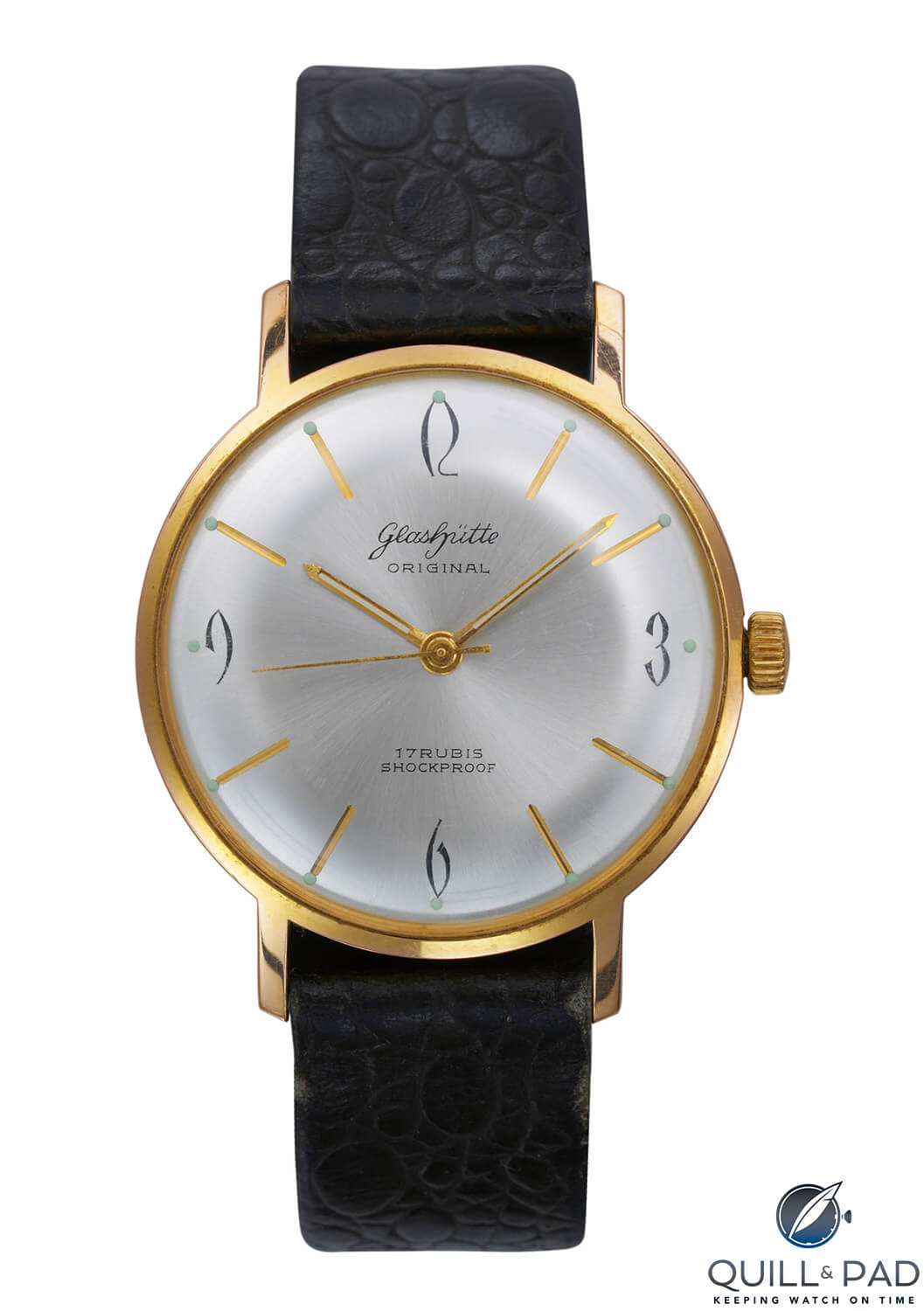
A Glashütte ‘Original’ GUB watch from the 1960s
Behind the iron curtain, the watchmakers of Glashütte were cut off from the rest of the industry and suppliers. From essential movement components such as ruby jewels and mainsprings to dials and hands, Glashütte watchmakers once again had to make these parts themselves. And they did.
One minor advantage from being behind the iron curtain was that Glashütte was also largely insulated from the effects of the quartz crisis. While this period in watch history wreaked havoc in the Swiss and American watchmaking industries, the Glashütte technicians adapted to making quartz watches, but always retained the production of mechanical watches as well.
And because the company was state-owned, VEB Glashütter Uhrenbetriebe became a behemoth of a company, employing more than 2,000 people. While the reunification of Germany, with the fall of the wall, brought freedom, it also brought unemployment.
And Glashütte’s products were not aligned with the needs of the modern consumer.
From the ashes, the phoenix will rise
In 1994 VEB Glashütter Uhrenbetriebe was bought by Heinz W. Pfeifer, but with only 72 employees it was a shell of its former self.
In homage to the glory years before the wars, he renamed the company Glashütte Original and found surprisingly fertile ground.
The company had never stopped making mechanical watches, not even at the height of the quartz crisis, and had maintained historical horological knowledge dating back to the four founding fathers of the watchmaking industry in Glashütte.
With the renaissance of the mechanical watch in full swing, these were the best ingredients for making a very appealing product for watch connoisseurs and collectors.

Glashütte Original watch factory in Glashütte, Germany
Pfeifer and his team restored the brand to the former glory Glashütte watches enjoyed before the wars in record time.
The designs of manufacture movements were updated so that they incorporated the traditional Glashütte decorations. Even complicated elements such as the perpetual calendar and the tourbillon re-emerged.
This success did not go unnoticed, and already in 2000 Glashütte Original was acquired by the Swatch Group, which remains the Saxon brand’s parent company.
Steady as she goes
Like many of its German counterparts, Glashütte Original is a constant performer. That may sound like a given, yet even in the world of haute horlogerie it is unfortunately not uncommon that a brand introduces a model that seems to be more focused on commercial performance and maximizing profits rather than building the brand and remaining in touch with its “DNA.”
Glashütte Original seems to take its time, unhurriedly creating something special, preferring quality over quantity.
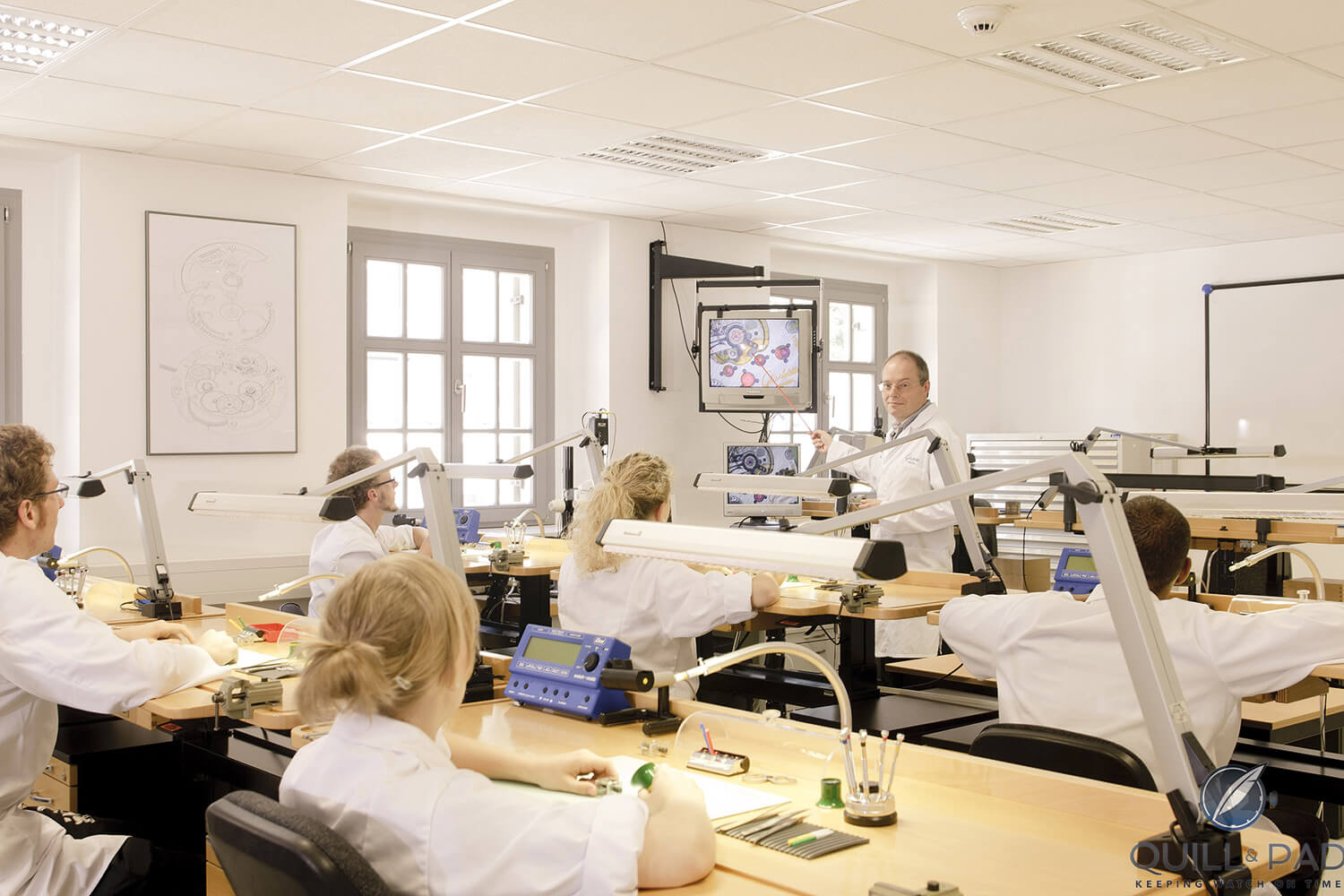
Glashütte Original Alfred Helwig School of Watchmaking
Glashütte Original operates its in-house Alfred Helwig School of Watchmaking where not only a new generation of watchmakers learn their trade the Glashütte way but also toolmakers, essential for any true manufacture. This is a long-term approach making the brand a consistent performer.
On the other side, this brand is what it is – and it is not afraid to show it. The days behind the iron curtain didn’t result in watches that we would rate very highly in comparison to the watches made before and after this period, but it is part of the company’s heritage.
There is pride in survival because this survival also resulted in the glorious brand it has become today. And, not to forget, Glashütte Original uses the designs of some models made behind the iron curtain as an inspiration for some of the modern-day collections, thus fully embracing its own genetic makeup (see Sixties Iconic: Glashütte Original’s Richly Multicolored Homage To Vintage East German Style).
Simple and complicated: the Glashütte Original Senator collection
Currently, Glashütte Original’s lineup comprises four different collections of which the Senator is considered the most classic.
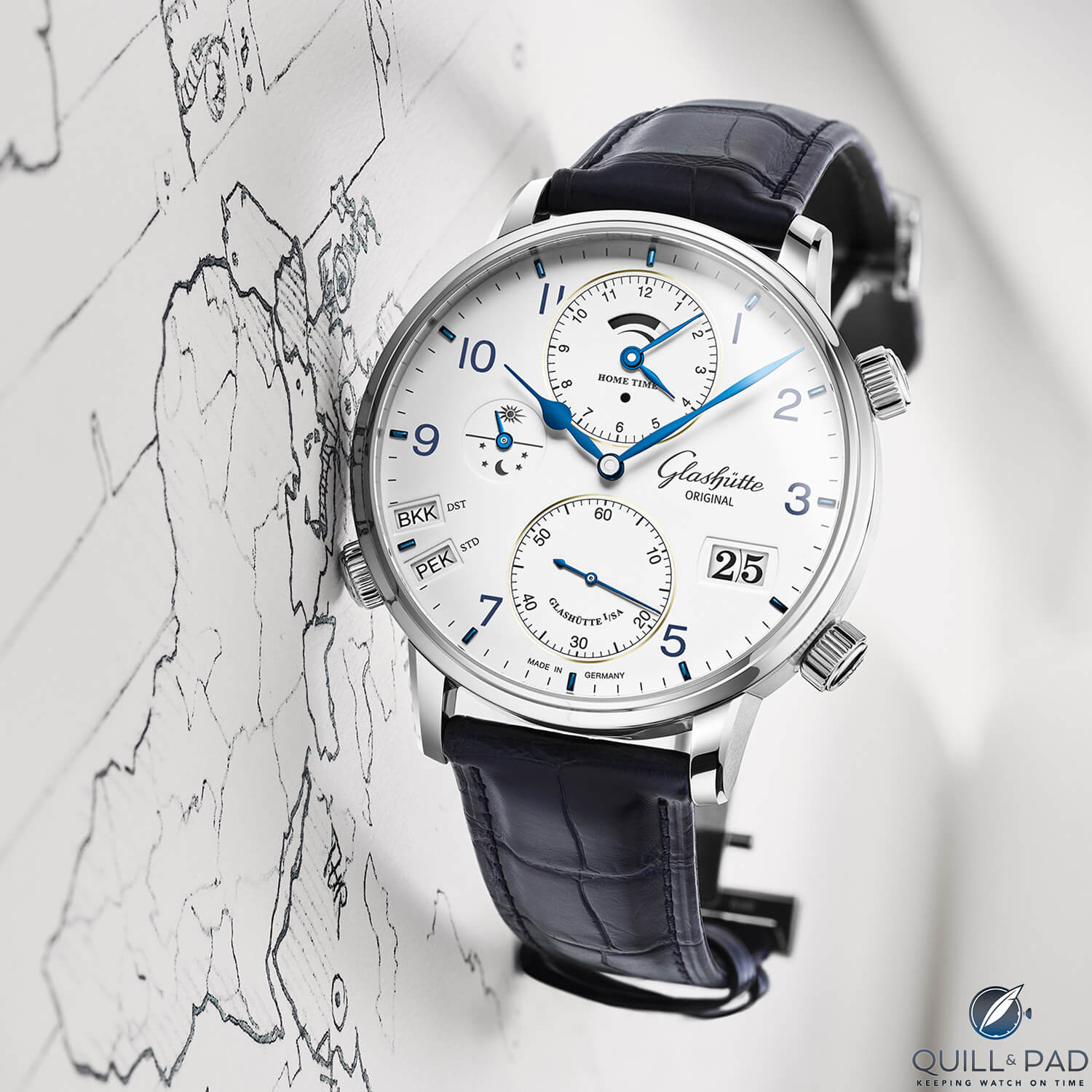
Glashütte Original Senator Cosmopolite
The brand is way too forward-thinking to dwell on the past in a serious way, and while the Senator collection indeed contains some watches with Roman numerals and blued hands, it is also home to contemporary timepieces.
A personal favorite here is the Senator Cosmopolite, which is one of the cleverest and most complete mechanical travel watches available.
It features all 35 time zones of the world, including those with only half-hour and quarter-hour differences. Despite its complexity, it remains easy to use and visually balanced.
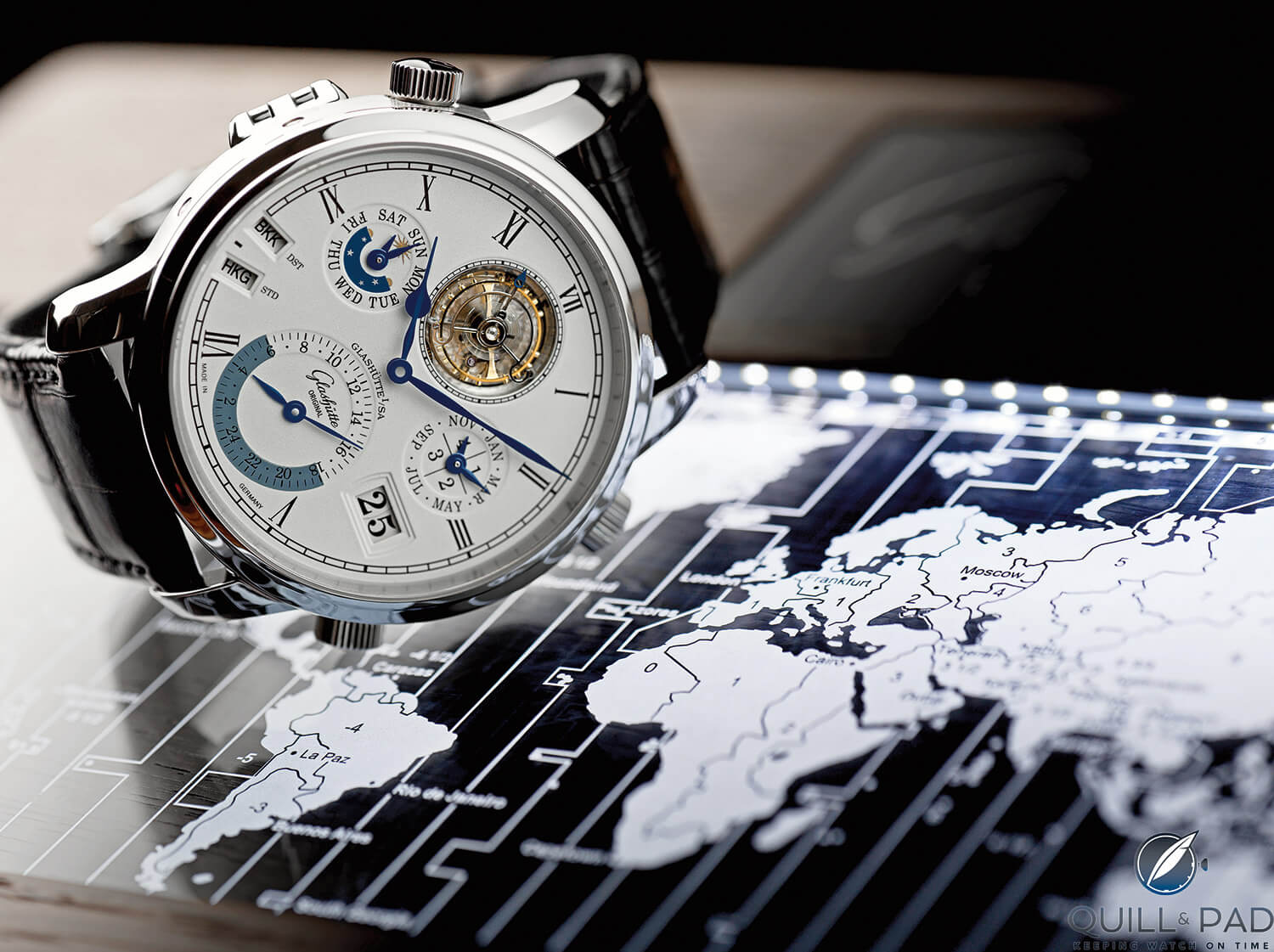
Glashütte Original Grande Cosmopolite Tourbillon
The Senator Cosmopolite is also available as Cosmopolite Grande Tourbillon, featuring the same base movement but with added complications plus a tourbillon regulator. This incredible compendium of complications basically showcases the technical prowess of Glashütte Original as it combines the functionality of the regular Cosmopolite with a flying tourbillon and a perpetual calendar – making it a true haute horlogerie feast in a 48 mm platinum case.
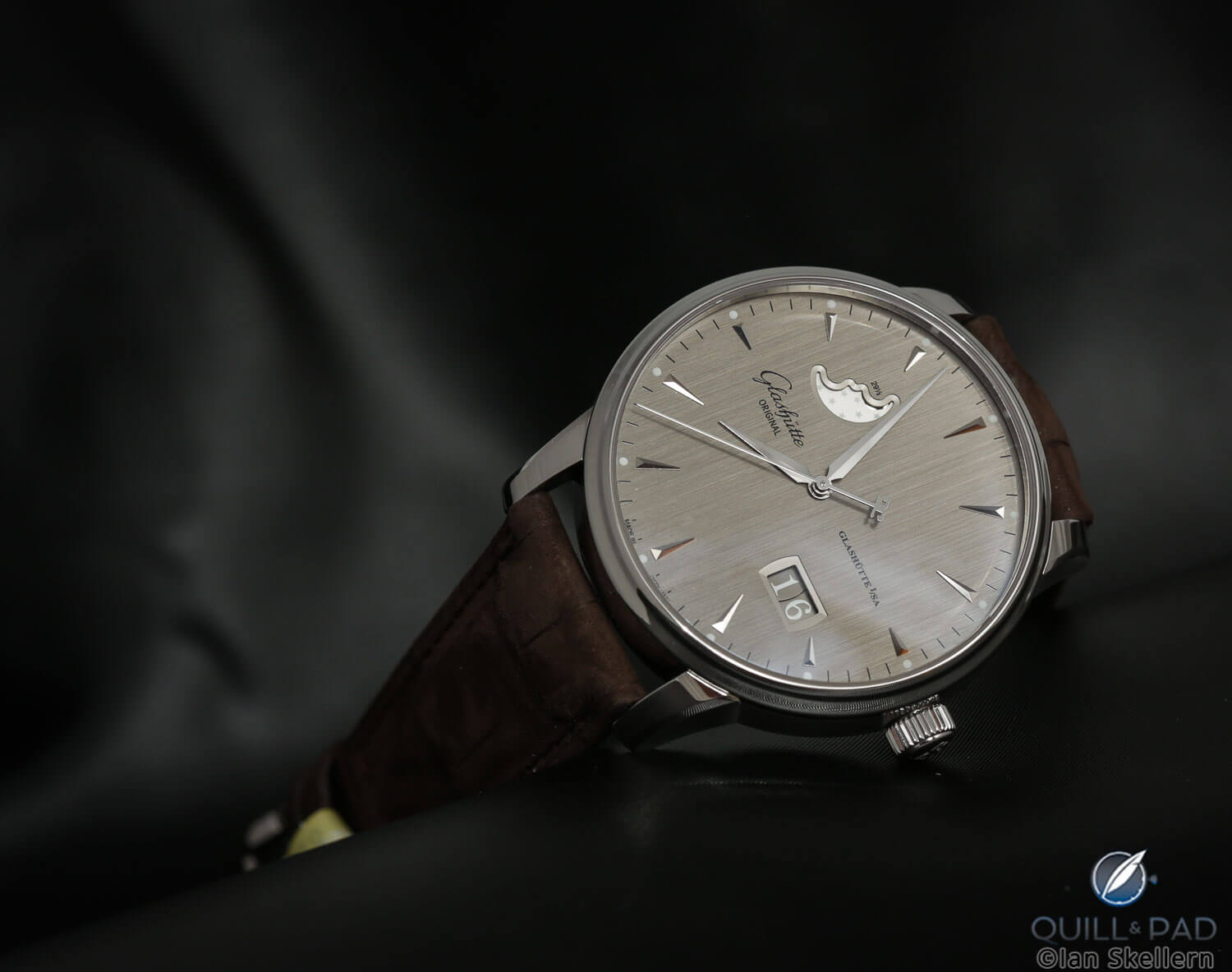
Glashütte Original Senator Excellence Panorama Date
Glashütte Original doesn’t always need to use technical complexity to make a point. A perfect example of this is the Senator Excellence Panorama Date, which the brand introduced in 2018: a simple three-hander with a large date in a steel case. However, the combination of the galvanized silver-grey or blue dial with vertically brushed finish and a nubuck brown alligator strap makes it an incredibly desirable proposition.
Asymmetrical balance: the Glashütte Original Pano collection
Asymmetrical dials are also something typical for Glashütte – thanks to A. Lange & Söhne’s Lange 1 from 1994, which kicked the style off. Glashütte Original highlights this in its Pano collection, where the PanoGraph resides.
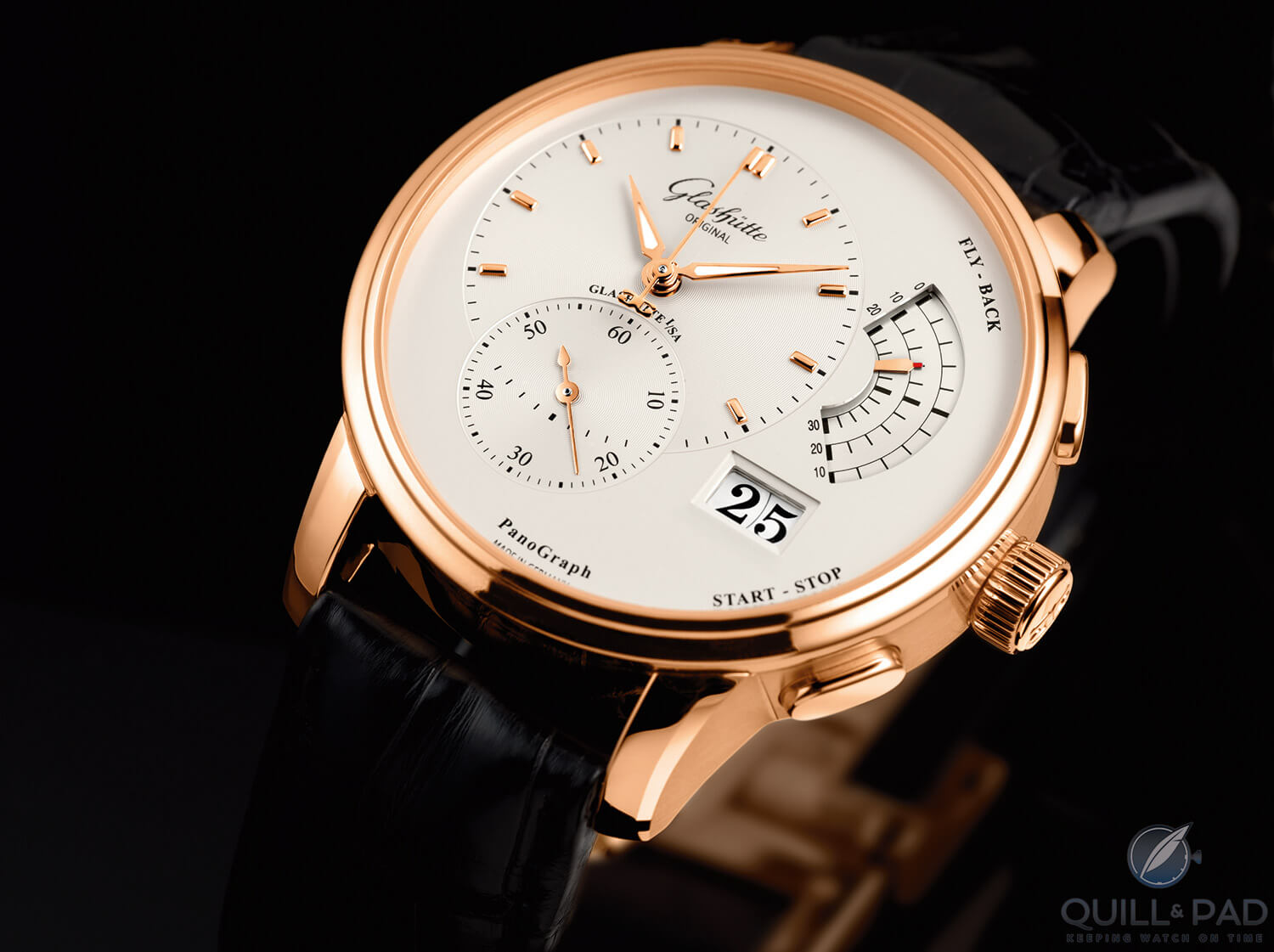
Glashütte Original PanoGraph
The PanoGraph boasts a special column-wheel flyback chronograph displaying its elapsed minutes like no other: an arched opening in the dial reveals a sectoral 30-minute counter, making this chronograph not only unique, but also extremely easy to read.
The PanoInverse is more a visual delight with the focus on the balance wheel placed prominently at the front of the dial thanks to an inverted movement.
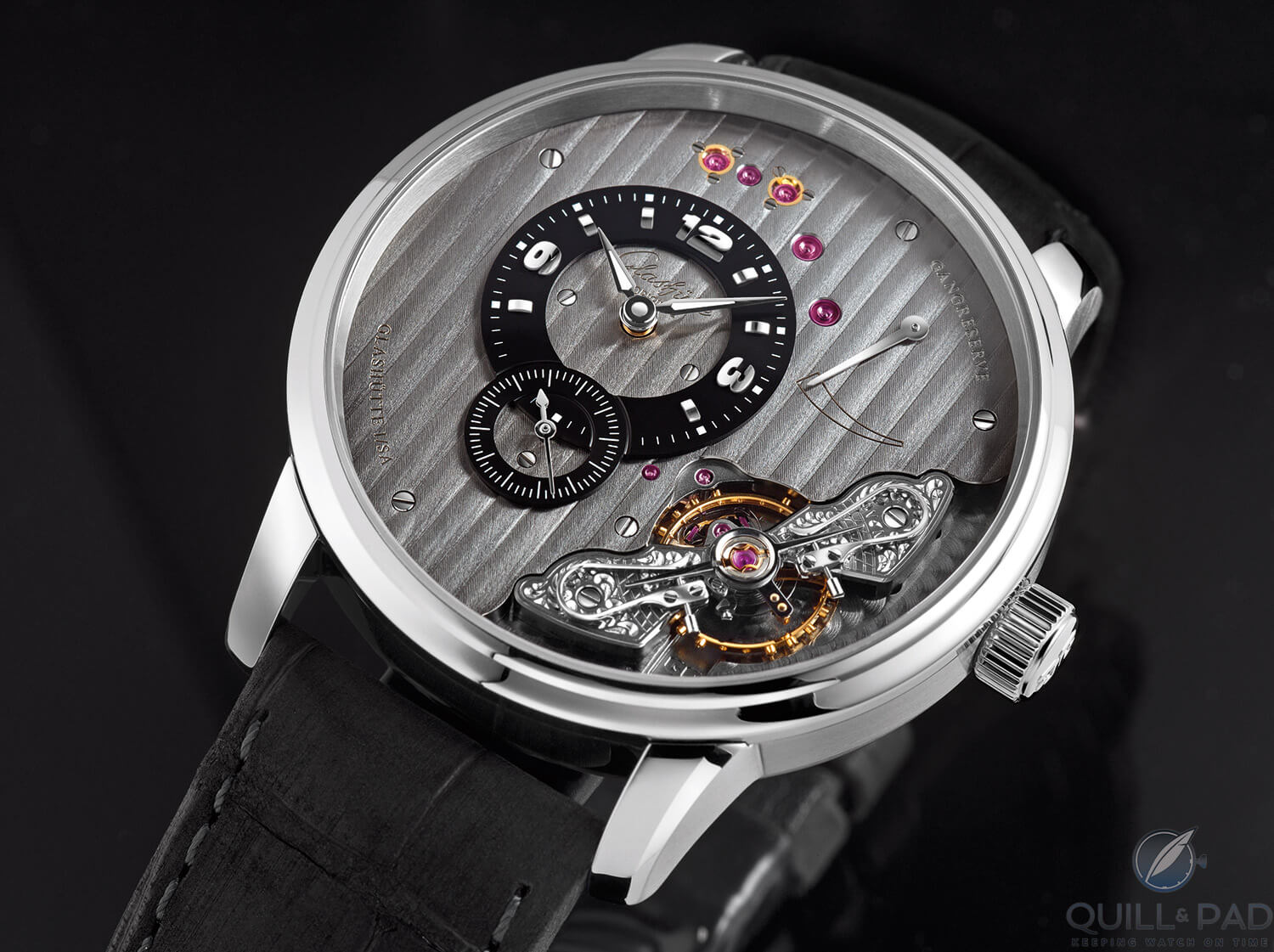
Glashütte Original PanoInverse
With its duplex swan-neck fine adjustment and hand-engraved balance cock, it comes across like an oasis in the three-quarter plate that covers the rest of the movement.
The Glashütte Original Vintage collection is not old
The inspiration for the Vintage collection comes mainly from Glashütte Original’s designs from its time behind the iron curtain, which have been used as inspiration in updating the historical features for contemporary wristwatches featuring modern in-house movements with high-quality finish such as the Seventies Chronograph Panorama Date.
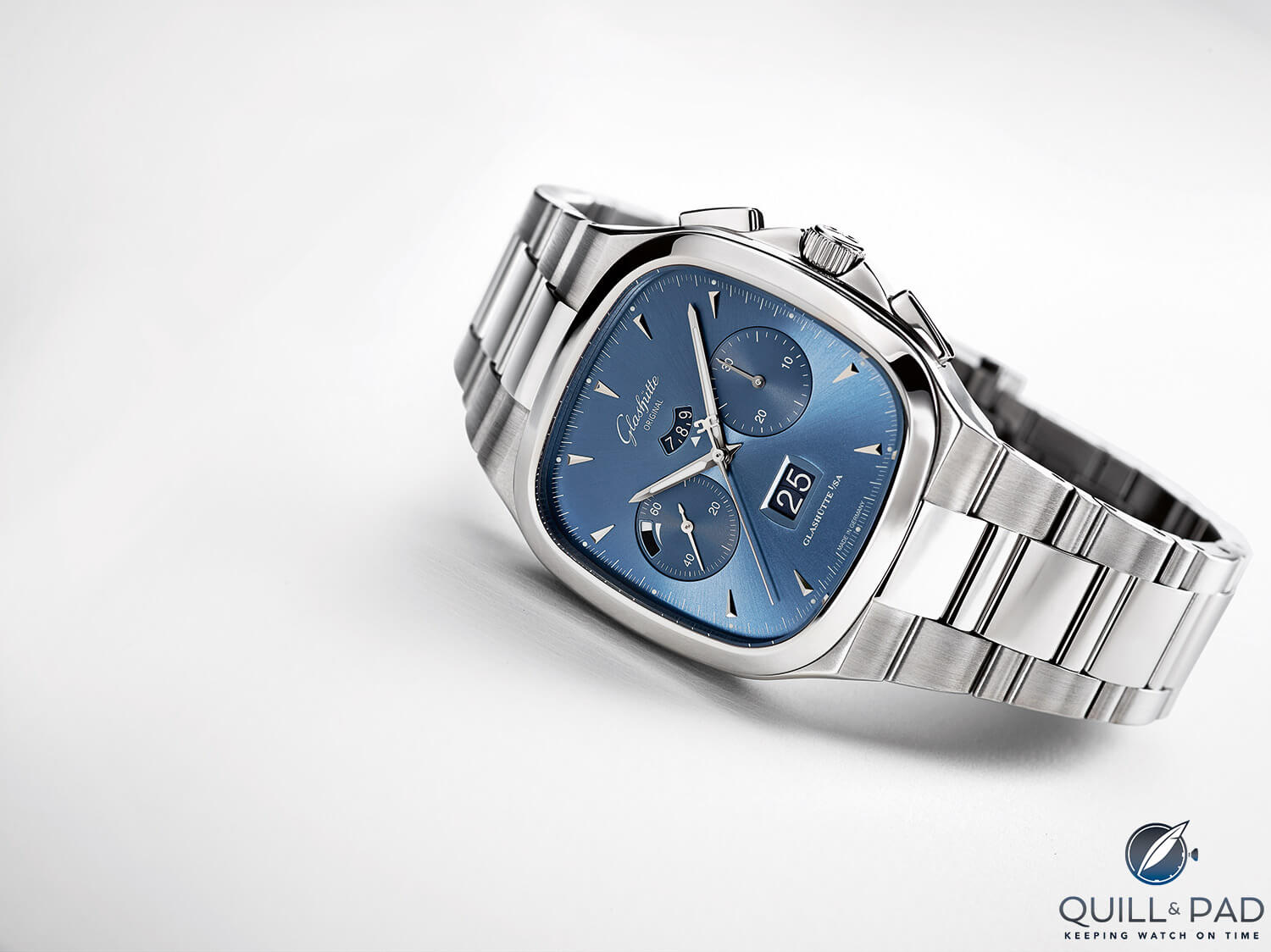
Glashütte Original Seventies Chronograph Panorama Date
The Sixties Panorama Date is a relatively modest watch with three hands and a large date, yet it becomes a visual powerhouse with the new varnished green dial with a vintage-style dégradé effect that Glashütte Original introduced at Baselworld 2018. The brand’s in-house dial manufacture found the pattern on an original stamping tool from the 1960s.
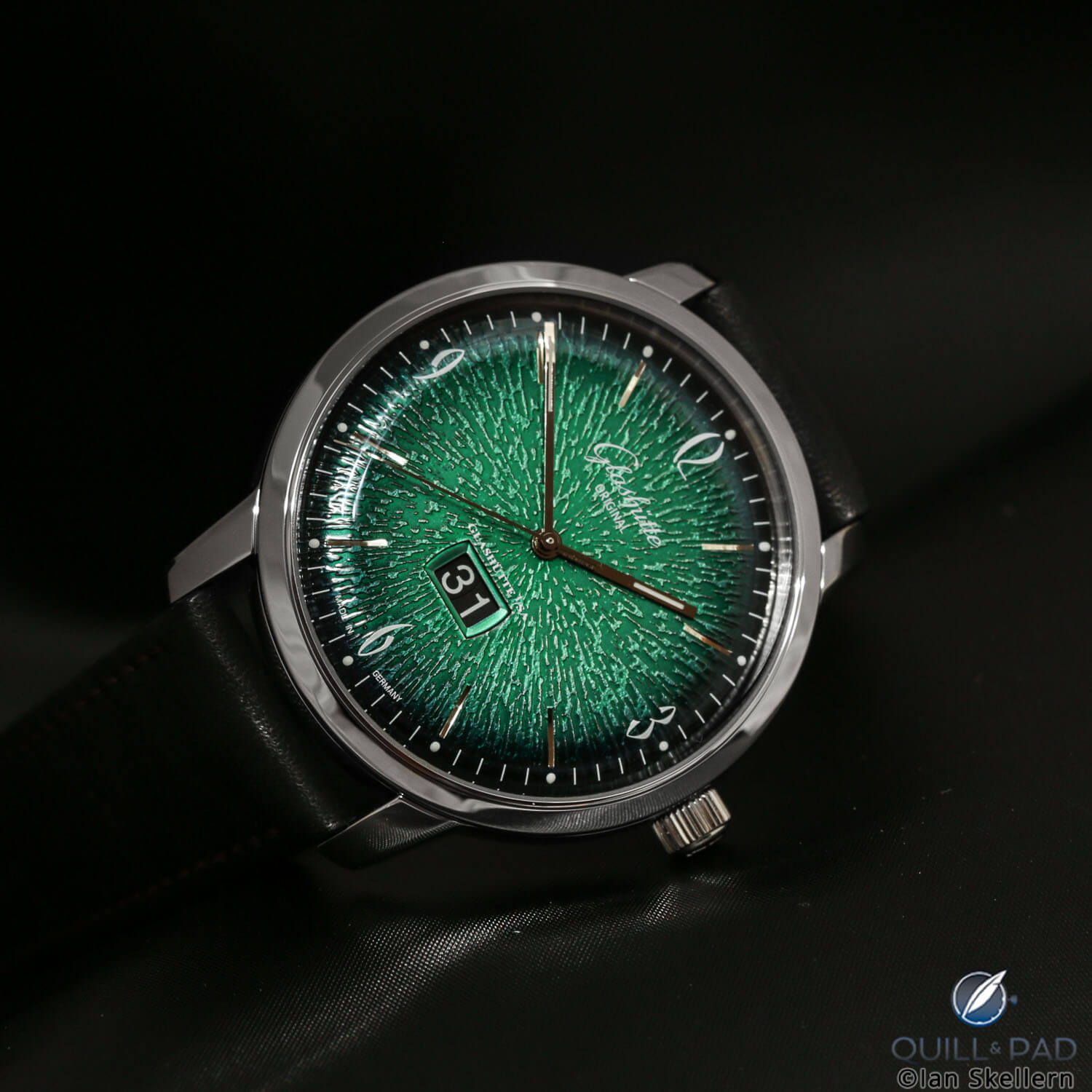
Glashütte Original Sixties Green Panorama Date
The result is stunning and eye-catching, not only because of its vibrant green color but also because of the impact that the pattern gives it. It is so hard to describe the effect this dial has on the overall this watch that in this case, one picture is worth a thousand words. And for those, please check out the article by Sabine Zwettler entitled Glashütte Original Sixties: Retro Chic Returns In A Stylish New Green.
Not to forget the ladies
The fourth pillar in Glashütte Original’s lineup is the Ladies’ collection. Thanks to the East German VEB, the brand can look back on a very long tradition of crafting watches for women, one that was also immediately continued by Pfeifer when he took over the company and turned it into Glashütte Original. Even the Sport Automatik, the brand’s sportiest offering with its typical ice cube bracelet design from the 1990s, was available in a female-oriented version.
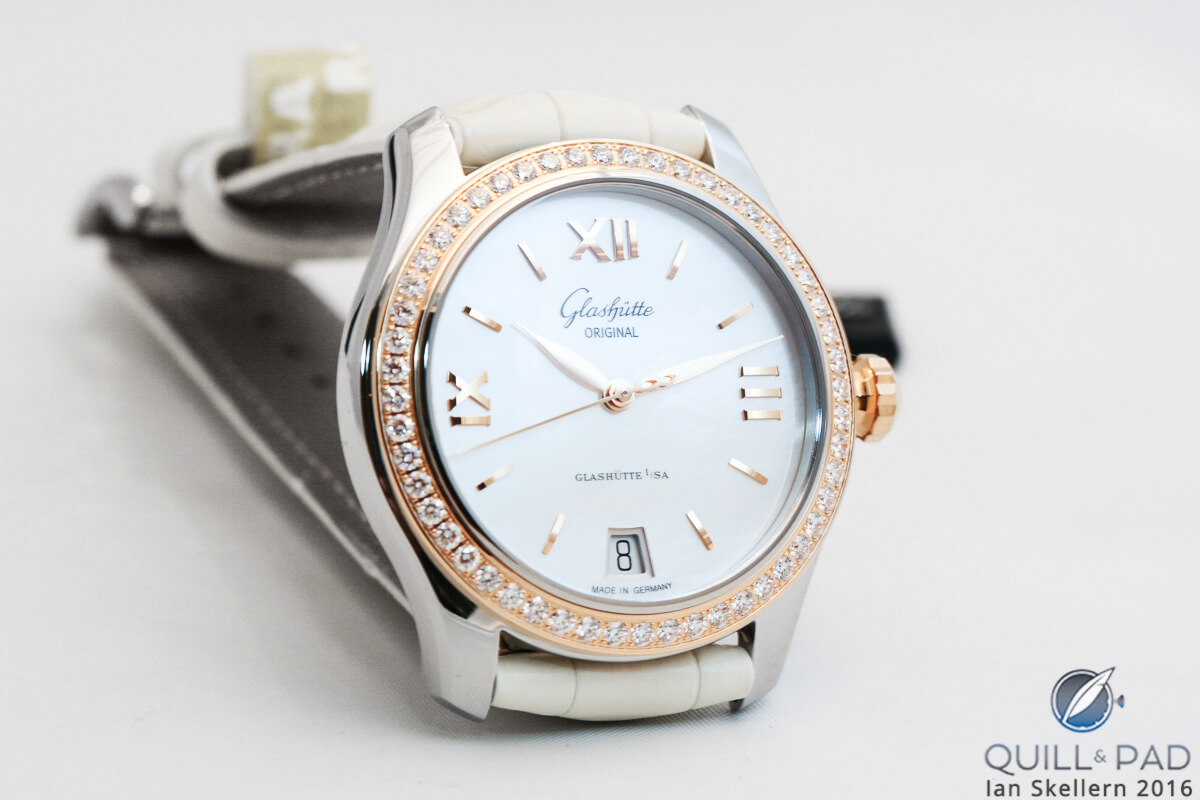
Glashütte Original Lady Serenade
Today Glashütte Original caters to women in a more specific and focused way, offering various PanoMaticLuna models in a more feminine style with mother-of-pearl dials and diamond settings. The Lady Serenade is a beautiful watch in a contemporary size available in a wide variety of different metals, dials, and diamond details. While beautiful, the watch remains focused on its practical purpose, and is, of course, fitted with a mechanical manufacture movement.
The Glashütte Original collection is best described as a meticulously selected assortment of German delicacies – of the horological kind, of course. The collection is future focused, crafted with care, and embracing the entire history of this German brand.
Quick Facts Glashütte Original Senator Cosmopolite
Case: 44 x 14 mm, stainless steel
Movement: automatic manufacture Caliber 89-02, power reserve 72 hours
Functions: hours, minutes, seconds; large date; power reserve indicator; day/night indicator; second time zone; display of summer/winter times of second time zone.
Price: $21,200 (buckle), $21,500 (folding clasp)
Quick Facts Glashütte Original Sixties Panorama Date
Case: 42 x 12.4 mm, stainless steel
Movement: automatic manufacture Caliber 39-47, power reserve 40 hours
Functions: hours, minutes, hacking seconds; large date
Price: €7,800/$9,300
You might also enjoy:
Sixties Iconic: Glashütte Original’s Richly Multicolored Homage To Vintage East German Style
Glashtte Original Sixties: Retro Chic Returns In A Stylish New Green.
How The Wall Came Tumbling Down: Made In Germany
German Watch Museum Glashütte: The Historical School Building Celebrates Its 100th Anniversary As A Modern Museum
Made In Germany: The Glory Of Glashütte
Leave a Reply
Want to join the discussion?Feel free to contribute!





















































Glad you mentioned Pfeifer, a remarkable autodidact but a bit of a ‘rough diamond’, often airbrushed out company histories; L & S never mention that they had to buy the company residue from him.